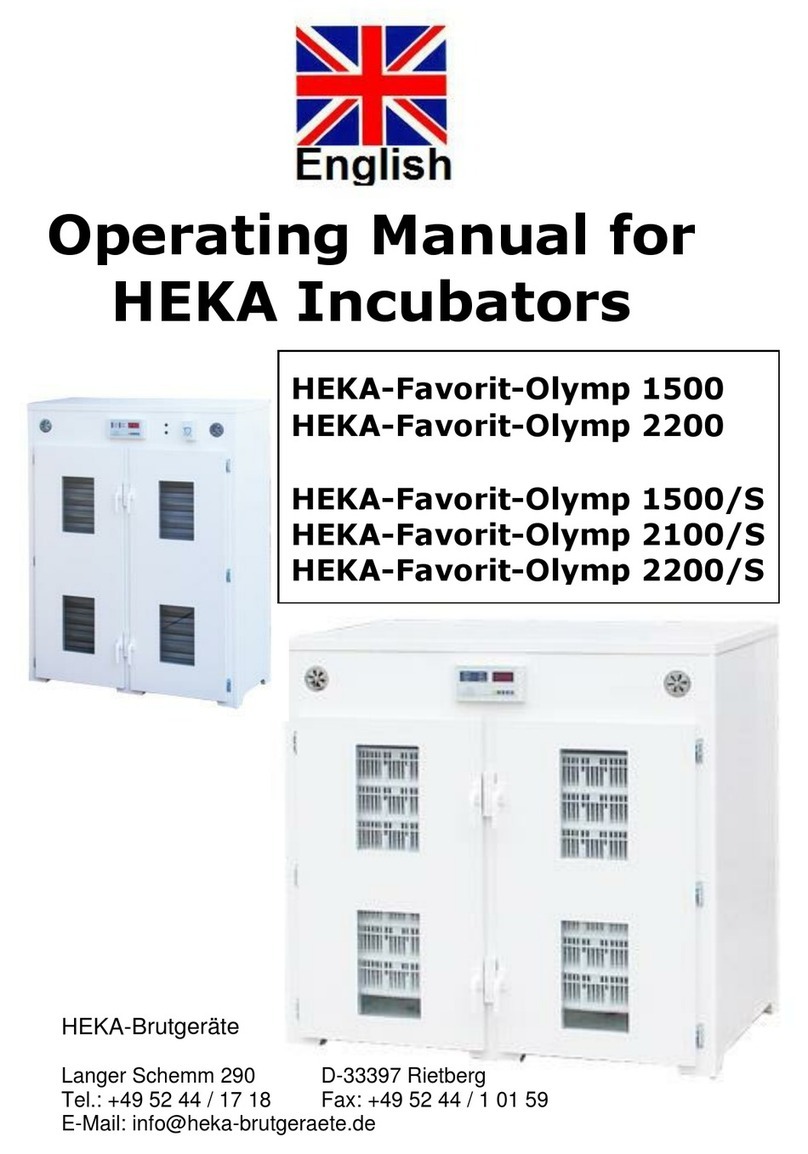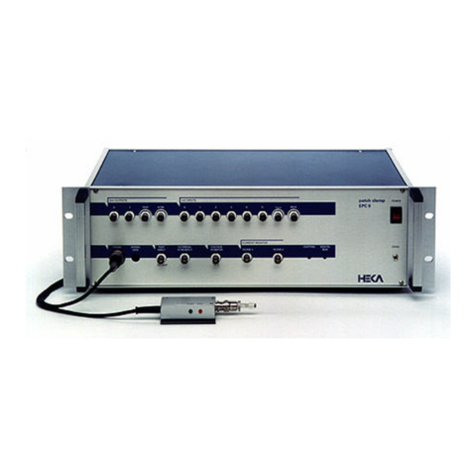HEKA Favorit-Eco 84 User manual

Operating Manual for
HEKA Incubators
HEKA-Brutgeräte
Langer Schemm 290
D-33397 Rietberg
Tel.: +49 52 44 / 17 18
Fax: +49 52 44 / 1 01 59
E-Mail: info@heka-brutgeraete.de
HEKA-Favorit-Eco 84
HEKA-Favorit-Eco 126
HEKA-Favorit-Eco 168
HEKA-Favorit-Eco 84+S
HEKA-Favorit-Eco 126+S
HEKA-Favorit-Eco 168+S
HEKA-Favorit-Eco 90/S
HEKA-Favorit-Eco 135/S

2
Preface
The purpose of this manual is to familiarise the reader with the incubator
and provide instructions on use.
The operating manual contains important information for the safe,
economic, and correct operation of the incubator. Compliance with this
manual helps to avoid dangers, minimise repair costs and downtime, and
increase the reliability and service life of the machine.
The operating manual is suitable for adding environmental protection
regulations to the instructions on the basis of existing national accident
prevention regulations.
The operating manual must always be kept at the place of deployment of
the incubator. All individuals who are authorised to work with the
incubator must read and observe the operating manual. This includes
instructions in the following areas:
●Operation
●Troubleshooting
●Care and maintenance
●Transport
The operator must ensure that only authorised persons work with the
incubator. The operator must check the incubator for externally visible
damage and defects on a daily basis. Moreover, the operator must
promptly report any changes that impair the safety. This also includes
changes in the operating behaviour. The incubator may only be operated
if its condition is flawless.
As a matter of principle, safety equipment must not be removed or
disabled.
Should it be necessary to remove safety equipment during preparation,
repair, or maintenance, the safety equipment must be reinstalled
immediately upon completion of the maintenance or repair work.
The manufacturer does not assume any liability for damages resulting
from unauthorised modification of the incubator.
All safety information and warnings on the incubator must be observed.
In addition to the information in the operating manual, the generally
applicable safety and accident prevention regulations must also be
complied with.

3
Structure of the safety instructions
All safety instructions have a uniform structure:
Pictogram (indicates the type of danger)
Caution! (indicates the severity of the danger)
Information (describes the danger and how it can be avoided)
Pictogram
Signal word
Meaning
Consequences of non-
observance
Danger!
Imminent danger to persons
Very severe to fatal
injury
General
danger
Warning!
Potentially very dangerous
situation for persons
Very severe to fatal
injury
Dangerous
electric
voltage
Caution!
Potentially dangerous situation
for persons
Minor injury
Attention!
Potential damage to property
Damage to the device
Useful information or tip
Other notes in the operating manual
Caution!
Risk of injury due to hot surface!
Warning pointing to a risk of injury to the operator from hot
surfaces.
Please read and observe the operating manual.
Disconnect the power plug before opening the device.

4
General safety instructions!
Caution!
Non-observance of the following safety precautions can result in
bodily injury or damage to the incubator.
Apart from the notes listed below, please also observe the
general safety and accident prevention regulations.
Read the operating manual!
Do not start using the incubator until you have read the
associated operating manual.
●Do not operate the incubator on the ground. Keep a minimum
distance of 50 cm from the ground!
●Do not use the incubator outdoors.
●Do not place the incubator in direct sunlight (counts also for
storage and transport).
●Before connecting the incubator, compare the voltage of the power
supply with the voltage on the type plate.
●In accordance with the intended use, the incubator may only be
used to incubate eggs.
●Never operate the incubator if any part(s) are damaged, if it does
not function properly, or if you suspect damage.
●Defective power cables may only be replaced by the manufacturer,
its customer service, or a similarly qualified person.
●Maintenance work may only be performed by appropriately trained
personnel.
●Repair work and special maintenance work may only be performed
by authorised personnel (manufacturer's personnel) or
appropriately trained personnel.
●Work on the electrical equipment may only be performed by
qualified electricians and persons instructed in electrical
engineering (see DIN VDE 0105).
●Working on live parts and equipment is not permitted.
●Conversion or modification of the incubator is not permitted.

5
Table of contents
Preface.... ................................................................................................2
Structure of the safety instructions ..........................................................3
General safety instructions......................................................................4
1Desciption............................................................................. 6
1.1 Technical data........................................................................6
1.2 Control panel..........................................................................7
1.3 Housing - back .......................................................................7
2Setup and connection........................................................... 8
2.1 Installing the incubation trays.................................................9
3Operating the incubator...................................................... 10
3.1 Switching on/off....................................................................10
3.2 Adjusting the set-values.......................................................10
3.2.1 Temperature set-value...............................................10
3.2.2 Humidity set-value .....................................................11
3.2.3 Double-thermostat and alarm settings.......................12
4Tips for successful incubation............................................. 13
4.1 Incubation temperature ........................................................13
4.2 Humidity ...............................................................................13
4.3 Turning the eggs ..................................................................15
4.4 Cooling-down the eggs ........................................................16
4.5 Inserting the hatching eggs..................................................17
4.6 Putting the eggs into the hatching-trays...............................17
5Shutting-down after incubation ........................................... 18
6Maintenance and care........................................................ 19
6.1 Incubation or hatching chamber of the device.....................19
6.2 Technical compartment (incubation or hatching device) .....19
6.3 Incubators with a separate hatching chamber (Favorit-Eco
84+S, 126+S, 168+S).....................................................................20
6.4 Float valve............................................................................20
6.5 Replacing the power cable...................................................21
7FAQs –Frequent questions................................................ 22
8Disposal ............................................................................. 23
9CE- Declaration of conformity............................................. 24
10 Appendix: Analysis of mistakes at incubation / bad hatching25
11 Appendix: Incubation Periods............................................. 26
This manual suits for next models
7
Table of contents
Other HEKA Laboratory Equipment manuals
Popular Laboratory Equipment manuals by other brands

Belden
Belden HIRSCHMANN RPI-P1-4PoE installation manual

Koehler
Koehler K1223 Series Operation and instruction manual

Globe Scientific
Globe Scientific GCM-12 quick start guide

Getinge
Getinge 86 SERIES Technical manual

CORNING
CORNING Everon 6000 user manual

Biocomp
Biocomp GRADIENT MASTER 108 operating manual
















